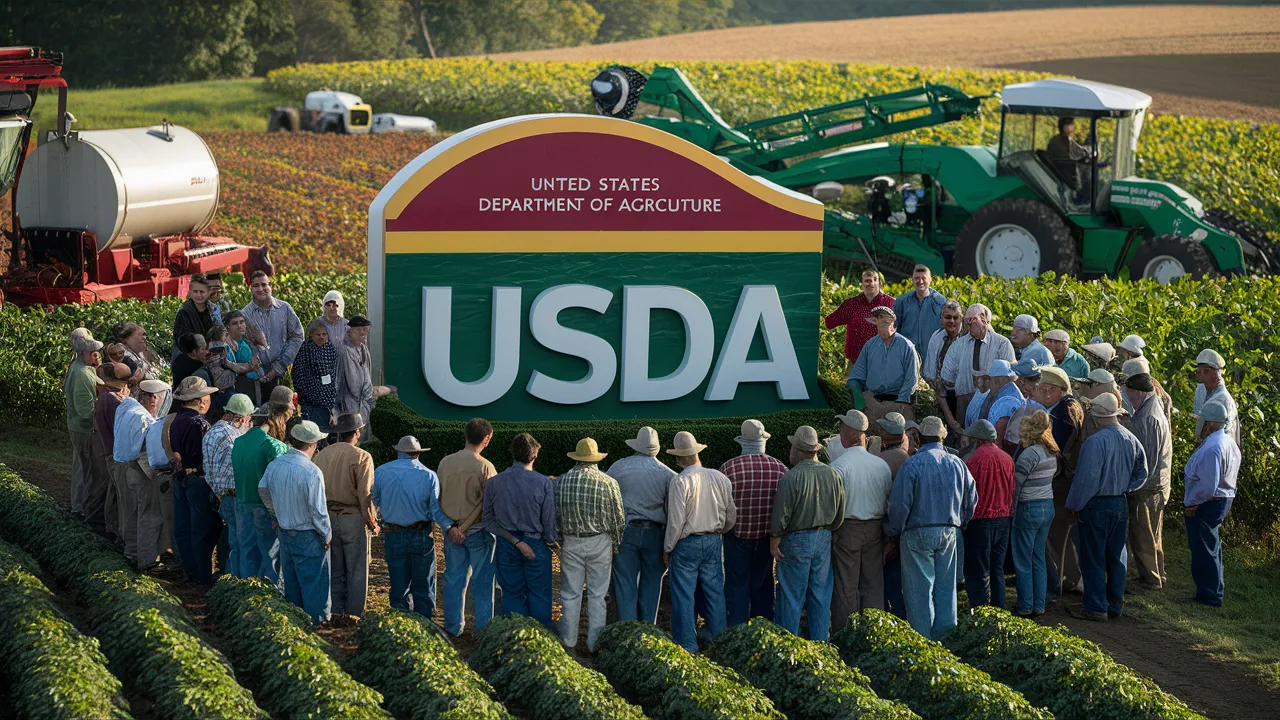In the intricate tapestry of agriculture in the United States, one entity stands out as a cornerstone of support and regulation: the United States Department of Agriculture (USDA).
As a pivotal player in shaping the landscape of farming practices, the USDA’s role extends far beyond mere bureaucracy; it embodies a nexus where governmental policies, scientific research, and practical applications converge to underpin the nation’s agricultural sector.
For farmers nurturing fields teeming with produce, agricultural professionals navigating market intricacies, policymakers charting future sustainability goals, and students delving into the foundations of agrarian science, unraveling the significance of USDA in agriculture unlocks a trove of knowledge that propels progress and innovation.
The USDA, unfurling its mandate across vast expanses of arable land and burgeoning farms, serves as an essential cog in the machinery that sustains American agriculture.
Understanding its multifaceted operations is not merely a scholarly pursuit but a pragmatic necessity for those ensconced within the realms of farming – an indispensable guidepost towards informed decision-making brimming with empirical insights and evidence-backed directives.
By peeling back layers of USDA initiatives tailored for farmers’ well-being, industry professionals’ prosperity, policymakers’ informed governance, and students’ educational enrichment, one unearths a mosaic that illuminates how this federal department empowers stakeholders at every echelon to thrive in an ever-evolving agricultural ecosystem.
Embark on this journey to decode the enigmatic world of USDA intricacies and unearth its hidden gems poised to shape the future horizons of farming practices with precision and purpose.
USDA: An Overview
The United States Department of Agriculture (USDA) stands as a pivotal entity in the realm of agriculture. As the acronym suggests, the USDA plays a multifaceted role in overseeing agricultural affairs within the United States, impacting various sectors from farming to food safety.
Its significance is deeply rooted in its mission to enhance agricultural productivity and competitiveness while ensuring the sustainability of natural resources. Through research, education, and regulatory functions, the USDA orchestrates efforts to support farmers, consumers, and the environment.
One primary function of the USDA lies in providing support to farmers through an array of programs aimed at enhancing crop yields, improving animal health standards, offering financial assistance for rural development projects, and safeguarding the industry against external threats like pests and diseases.
For example, under the Farm Service Agency (FSA), farmers can access loans or disaster relief programs during challenging times such as natural disasters or market downturns. Additionally, the USDA’s Agricultural Marketing Service establishes grading standards for commodities like fruits and vegetables which not only ensure quality but also facilitate fair pricing mechanisms in the market.
Regulation also constitutes a core responsibility of the USDA to maintain food safety standards across various stages of production and distribution. Agencies like the Food Safety Inspection Service (FSIS) enforce rigorous guidelines to prevent foodborne illnesses by inspecting meat, poultry, and egg products before they reach consumers’ plates.
Furthermore, through initiatives like the National Organic Program (NOP), which certifies organic products meeting strict production criteria, the USDA ensures consumer trust in organic labeling while supporting sustainable agricultural practices.
In essence, understanding the comprehensive role that the USDA plays is crucial for all stakeholders involved in agriculture to navigate effectively within this complex ecosystem.
Impact on Farmers.
The USDA plays a pivotal role in supporting farmers and shaping the landscape of American agriculture. By understanding how USDA programs directly influence farmers’ livelihoods, one can grasp the depth of impact this department has on the agricultural sector.
A notable initiative is the Farm Service Agency (FSA), which provides vital resources such as loans, disaster assistance, and risk management tools to help farmers navigate financial challenges. For instance, during natural disasters like hurricanes or droughts, the FSA steps in to offer support packages that help farmers recover and sustain their operations.
Moreover, the USDA’s National Institute of Food and Agriculture (NIFA) funds research projects aimed at improving farming practices and crop yields. This research not only benefits farmers by providing them with innovative techniques but also contributes to the overall advancement of agriculture in the country.
By leveraging resources like grants from NIFA, farmers can access cutting-edge knowledge that enhances their productivity and efficiency. For example, NIFA-funded studies on sustainable irrigation methods have helped farmers conserve water while maximizing crop growth, showcasing the practical impact of USDA initiatives on real-world farming scenarios.
In addition to financial aid and research opportunities, the USDA’s Rural Development programs offer crucial support to rural communities where many farmers reside. Through initiatives like infrastructure development grants or housing assistance programs for rural residents, farmers benefit indirectly from improved living standards in their areas.
The USDA’s holistic approach aligns with its mission to not only assist individual farmers but also cultivate thriving rural economies as a whole. In essence, these various services provided by the USDA underscore its integral role in safeguarding the livelihoods of American farmers across different facets of agricultural operations.
Influence on Agricultural Industry Professionals
Agricultural industry professionals play a vital role in leveraging USDA resources and regulations to enhance their operations’ efficiency and adhere to industry best practices. The USDA provides crucial information, guidelines, and support that aid professionals in optimizing their agricultural processes while ensuring compliance with regulatory standards.
Through cooperative programs and partnerships, industry professionals have access to valuable research findings, training opportunities, and technical assistance offered by the USDA.
Collaboration with the USDA serves as a catalyst for driving innovation within the agricultural sector. By working closely with USDA representatives and experts, industry professionals can stay abreast of cutting-edge techniques, technologies, and methodologies that can boost productivity and sustainability in farming practices.
For instance, through initiatives like the Agricultural Marketing Service’s Specialty Crop Block Grant Program, professionals specializing in niche agricultural areas receive financial support and technical guidance to expand their market reach and utilize advanced production methods effectively.
Furthermore, adherence to USDA regulations fosters a culture of quality control and standardization across the agricultural industry. By following USDA standards for grading, labeling, and safety protocols, professionals can uphold consumer trust and ensure product consistency within domestic and international markets.
This alignment with USDA regulations not only benefits individual enterprises but also contributes to elevating overall industry standards, promoting transparency, reliability, and credibility in agricultural trade practices.
Policy Making with USDA Guidelines.
Policymakers play a crucial role in shaping the agricultural landscape, and the USDA provides essential guidelines that influence policy decisions at local, state, and national levels. By leveraging USDA recommendations, policymakers can develop frameworks that support sustainable farming practices, ensure food safety standards, and enhance overall agricultural productivity.
For instance, when crafting subsidy programs for farmers, policymakers often refer to USDA data on crop yields and market demands to align financial support with key agricultural priorities effectively.
Successful policy implementations rooted in USDA guidelines have yielded tangible benefits across various sectors of agriculture. One noteworthy example is the implementation of conservation programs based on USDA recommendations.
By aligning policies with the USDA’s conservation strategies, policymakers have facilitated widespread adoption of soil health practices, water management techniques, and biodiversity preservation efforts. These initiatives not only foster environmental sustainability but also contribute to long-term resilience in the face of changing climatic conditions.
Moreover, the USDA’s research findings serve as a cornerstone for evidence-based policymaking in agriculture. Policymakers rely on USDA data on crop disease trends, pest infestations, and emerging technologies to craft regulations that safeguard both farmers’ interests and consumer health.
For instance, the implementation of pesticide use restrictions and organic farming certifications are closely linked to scientific research conducted by the USDA, ensuring that agricultural policies are informed by rigorous analysis and expertise within the field.
In conclusion, policymakers who integrate USDA guidelines into their decision-making processes demonstrate a commitment to fostering innovation, sustainability, and economic growth within the agriculture sector.
By collaborating with the USDA and embracing its evidence-based recommendations, policymakers can navigate complex agricultural challenges adeptly while steering towards a more resilient and productive future for farmers and consumers alike.
Educational Value for Agricultural Students.
The USDA plays a crucial role in providing valuable educational resources for agricultural students, nurturing the next generation of professionals in the field. Through extensive research initiatives and practical programs, the USDA offers students insights into real-world agricultural challenges they are likely to face in their careers.
By engaging with USDA practices and research findings, students gain a deeper understanding of complex agricultural systems, sustainability practices, and innovative technologies shaping the industry.
For instance, the USDA’s Agriculture Research Service (ARS) conducts cutting-edge research projects that not only advance knowledge within the sector but also provide invaluable learning opportunities for students pursuing agricultural studies.
These research findings often translate into educational materials that support academic curricula and expose students to state-of-the-art agricultural practices. Moreover, through collaborations with universities and extension programs, the USDA ensures that students have access to current information and hands-on experiences that can shape their future contributions to agriculture.
By immersing themselves in USDA resources, such as publications, workshops, and internships, agricultural students can bridge the gap between theoretical knowledge acquired in classrooms and practical skills required in agricultural settings.
This exposure not only enhances their academic journey but also prepares them to address pressing issues like food security, environmental sustainability, and technological innovation in agriculture effectively.
Ultimately, leveraging the educational value provided by the USDA equips students with a holistic understanding of the multifaceted nature of agriculture while inspiring them to become catalysts for positive change within the industry.
Technological advancements in agriculture play a crucial role in shaping the future of farming practices, sustainability, and productivity. The USDA has been a significant driver behind fostering innovation through research funding and supporting cutting-edge technologies within the agricultural sector.
By investing in research projects and collaborations with academic institutions and industry partners, the USDA accelerates the development and implementation of advanced agricultural technologies.
One example of technological advancements supported by the USDA is precision agriculture. Through initiatives like the Precision Agriculture Initiative, the USDA promotes innovative tools such as drones, satellite imaging, soil sensors, and GPS technology to enable farmers to optimize their use of resources like water, fertilizers, and pesticides.
These technologies not only increase efficiency but also reduce environmental impact by minimizing inputs while maximizing yields. Precision agriculture contributes to sustainability by promoting resource conservation and reducing waste.
Moreover, the USDA has championed research on biotechnology applications in agriculture to enhance crop resilience, disease resistance, and nutritional content. Biotechnological innovations supported by the USDA have led to the development of genetically engineered crops that are more drought-tolerant or pest-resistant, contributing to increased crop yields and reduced reliance on chemical inputs.
By endorsing these advancements, the USDA ensures that farmers have access to tools that promote sustainable agricultural practices while addressing challenges related to climate change and food security. The integration of biotechnology into farming practices underscores the potential for science-driven solutions in addressing pressing agricultural issues.
In conclusion, technological advancements spearheaded by the USDA not only enhance productivity and profitability for farmers but also play a pivotal role in achieving sustainable agriculture goals.
By empowering farmers with state-of-the-art tools and techniques grounded in research-backed approaches, the USDA paves the way for a more resilient and efficient agricultural sector capable of meeting future challenges.
Embracing technological innovations supported by the USDA is key to creating a thriving agricultural industry that is environmentally conscious, economically viable, and socially responsible.
Sustainability Initiatives Driven by USDA.
The USDA plays a crucial role in driving sustainability initiatives within the agricultural sector by promoting environmentally friendly practices. One key initiative led by the USDA is the Conservation Reserve Program (CRP), which encourages farmers to convert environmentally sensitive agricultural land to conservation areas.
Through this program, farmers receive rental payments and cost-share assistance for restoring and protecting land, reducing soil erosion, and enhancing wildlife habitats. The CRP has had a significant long-term impact on sustainable farming methods by not only safeguarding natural resources but also improving soil health and water quality.
In addition to the CRP, the USDA’s Natural Resources Conservation Service (NRCS) provides technical and financial assistance to help farmers implement conservation practices on their land. These practices include cover cropping, crop rotation, integrated pest management, and precision agriculture techniques aimed at reducing environmental impacts while maintaining or increasing productivity.
By supporting these initiatives, the USDA contributes to conservation efforts that benefit both farmers and the environment in the long run.
Furthermore, the USDA’s focus on sustainable agriculture extends to promoting organic farming practices through various programs and certifications. The National Organic Program (NOP) administered by the USDA ensures that organic products meet consistent standards from farm to market.
This support for organic farming not only reduces reliance on synthetic inputs but also promotes biodiversity, improves soil health, and minimizes adverse effects on ecosystems. By guiding farmers towards more sustainable production methods, the USDA plays a vital role in fostering a balance between agricultural productivity and environmental stewardship.
Conclusion: Looking Ahead with a Focus on Innovation.
As we conclude our exploration of the USDA’s pivotal role in agriculture, it is evident that this department stands as a cornerstone for the development and sustainability of agricultural practices in the United States. Moving forward, a crucial aspect to consider is the integration of innovation within the framework of USDA operations.
By embracing cutting-edge technologies, research methodologies, and sustainable practices, the USDA can continue to drive progress in the agricultural sector while addressing evolving challenges such as climate change, resource scarcity, and market demand fluctuations.
In an era where innovation serves as a catalyst for growth and resilience, leveraging technological advancements supported by USDA-funded research becomes indispensable for ensuring food security, economic stability, and environmental conservation.
By fostering a culture of continuous improvement and adaptation to emerging trends, the USDA can spearhead transformative changes that not only enhance productivity but also promote long-term sustainability across all facets of agriculture.
Thus, by looking ahead with a steadfast focus on innovation, the USDA solidifies its position as a beacon of progress in shaping the future landscape of American agriculture.



